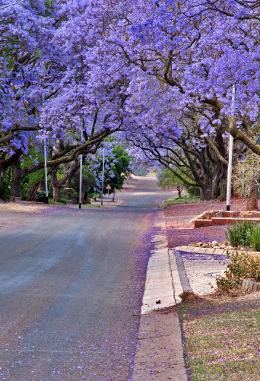If you are living in a drab and colorless neighborhood, then you can bring some life to it by planting some colorful flowering trees. Read this article for information about different purple flowering tree varieties in this article.

Growing purple flowering plants and trees near residential complexes gives them a scenic look. Apart from the general knowledge about these trees, one should also gain information about how to identify them. There are many different trees with purple colored flowers found in different parts of the world. Here is a description of few of those trees, along with the methods of identifying them.
Identification
There are different trees which produce purple flowers, and one should learn to identify these on the basis of their leaves. The flowers, barks, and structure and edges of leaves prove to be useful in identification. To identify trees on the basis of flowers, the bloom time, color, and structure are taken into account. The bark of trees can be differentiated on the basis of color, structure, texture, and other features. For example, the ease with which it can be peeled off is observed and is also taken into account. The shape, size, and canopy of the trees can also be used in the process of identifying them. Based on the characteristics of leaves, flowers, and other parts of the trees, one can find out the difference between various trees with the help of information available in encyclopedias and the Internet.
To identify spring trees, one should first check whether they are coniferous or deciduous. The coniferous trees are evergreen and their seeds are enclosed in cones. Spruce, fir, and cedar are a few of the coniferous trees that produce purple flowers. The deciduous trees shed their leaves in autumn; oak and rhododendrons are included in this category of deciduous trees. Arrangement of leaves is an important factor in identifying the spring trees. Leaves may display opposite or alternate arrangement. The arrangement can also be classified as simple and compound. Simple leaves directly grow from twigs, while compound leaves are arranged in groups of 3 or more leaflets. The margin of leaves could be entire, ridged, serrate, etc.
Examples
Some of the important purple flowering plants are described in the following paragraphs.
- Jacaranda:
Jacaranda is a genus of various plant species that produce purple flowers. There are as many as 49 species that come under this genus. It is native to the Caribbean islands, Central America, and South America. The height of these plants ranges from 60-90 feet.
- Buttonwood:
The botanical name of Buttonwood tree is Conocarpus erectus. This is a mangrove tree and is commonly found in urban areas. Parking lots and areas surrounding the residential complexes are the places where these trees can be seen. This tree is salt tolerant and survives poor drainage conditions. It is an evergreen tree and produces inconspicuous flowers throughout the year. It prefers bright sunlight and can grow well in loamy, clay, and sandy soils.
- Orchid Trees:
The Orchid tree has many species grouped under the genus Bauhinia. These trees can be evergreen, semi-evergreen, or even deciduous. Growing up to a height of 25-30 feet, the expanse of their canopy is almost 30 feet. This tree needs well-drained clay or loamy soil and bright sunlight for healthy growth.
- Frangipani:
It is a deciduous tree that produces purple-colored flowers. It sheds its leaves between December and March. The blooms are produced at the ends of branches and clusters of leaves are present near every flower. Apart from purple, many different colored Frangipani flowers are seen. The five-petalled flowers of this tree are fragrant.
If one is interested in the gardening, especially in the flowering plants, the different types of purple flowering trees mentioned above can be used to enhance the appearance of residential complexes, farm houses, and cottages to give a unique appearance to the surroundings.






 Growing purple flowering plants and trees near residential complexes gives them a scenic look. Apart from the general knowledge about these trees, one should also gain information about how to identify them. There are many different trees with purple colored flowers found in different parts of the world. Here is a description of few of those trees, along with the methods of identifying them.
Growing purple flowering plants and trees near residential complexes gives them a scenic look. Apart from the general knowledge about these trees, one should also gain information about how to identify them. There are many different trees with purple colored flowers found in different parts of the world. Here is a description of few of those trees, along with the methods of identifying them.